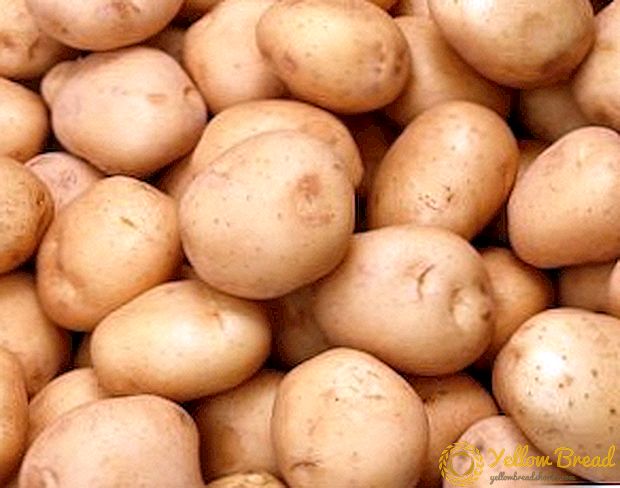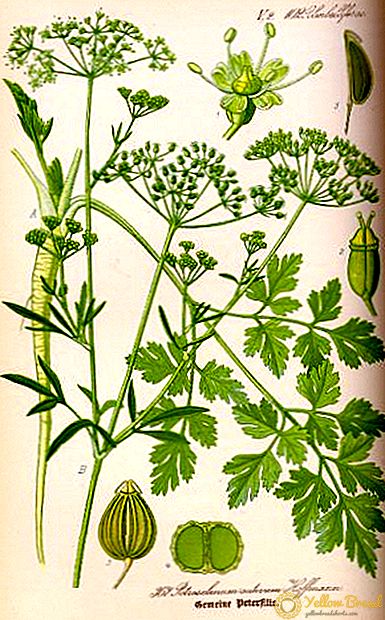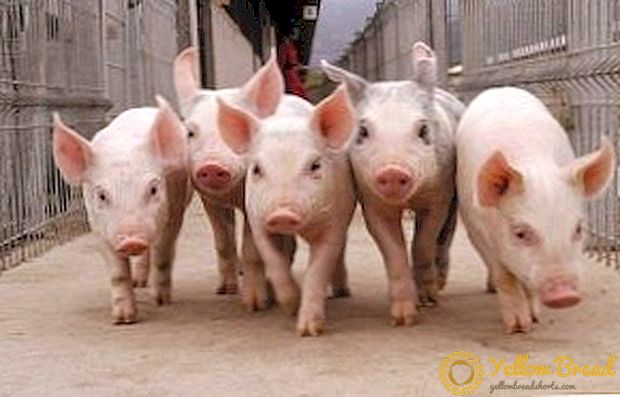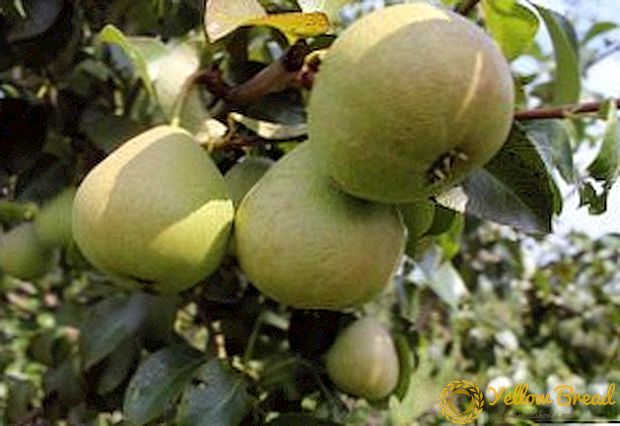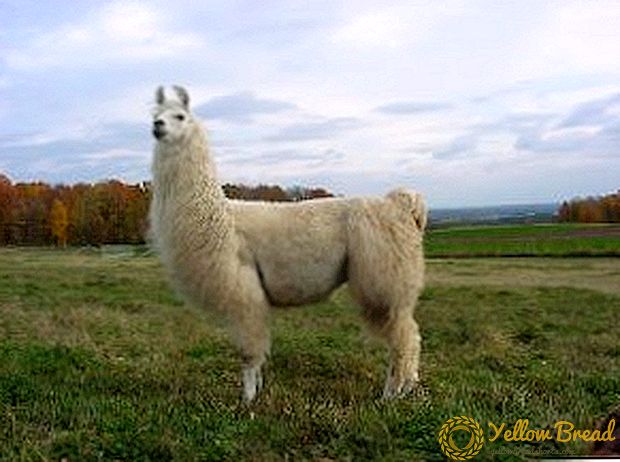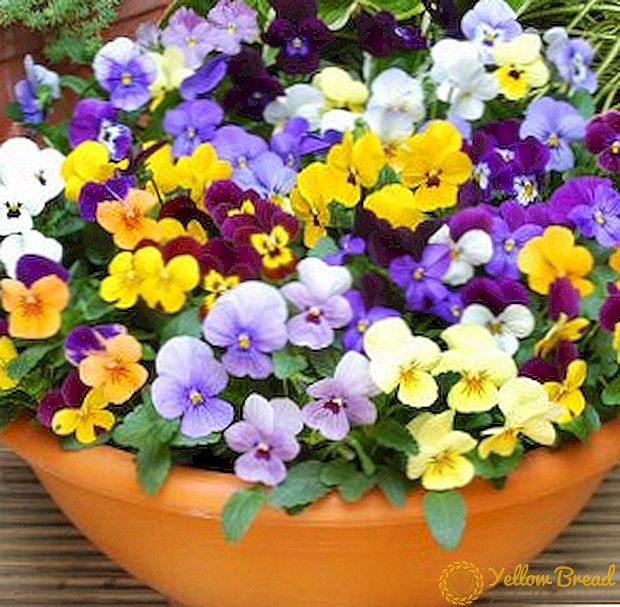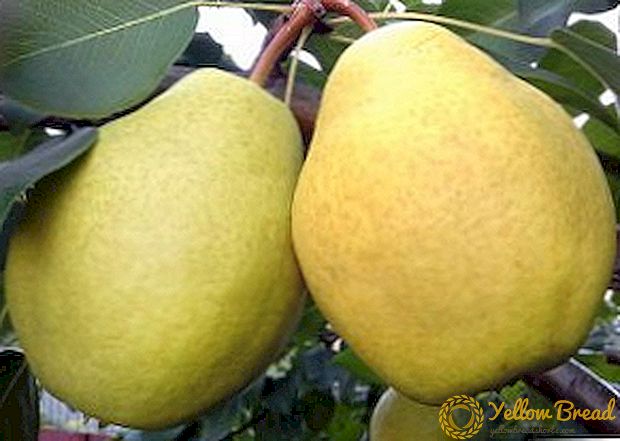 Each owner wants to find a variety of pears, which not only will be easy to care for, but also be able to produce products with excellent taste. Although many pear varieties have good yields, they produce products that do not have good taste.
Each owner wants to find a variety of pears, which not only will be easy to care for, but also be able to produce products with excellent taste. Although many pear varieties have good yields, they produce products that do not have good taste.
Today we will discuss an excellent variant of the usual plant - the “Larinska” pear, and also we will offer a full description of the variety, let's deal with the choice of planting material and tree care.
- Breeding history
- Description and distinctive features of the variety
- Wood
- Fruits
- How to choose the seedlings
- Choosing the right place
- Site preparation
- Step-by-step instructions for planting seedlings
- Seasonal care features
- Soil care
- Top dressing
- Preventive spraying
- Cropping and crown formation
- Protection against cold and rodents
Breeding history
The autumn pear variety was bred in the South Ural Scientific Research Institute for Horticulture and Potato. The material for the creation of "Larinskaya" were famous varieties: "Favorite Clapp" and "Ussuriyskaya".  It is listed in the State Register as a variety recommended for planting in the Urals region.
It is listed in the State Register as a variety recommended for planting in the Urals region.
Description and distinctive features of the variety
Next, let's talk about the main features of the aerial parts and fruits.
Wood
The elevated part has an impressive height - up to 6 meters. At the same time, the pear grows quickly enough, so by the time of fruiting the tree will have considerable dimensions. The crown has an average thickening, while the branches form an irregular shapeless crown, as they are bent in different directions. The barrel has the shape of a cylinder, most often - a straight, very rarely you can see the torsion. Sheet plates are quite large, have an elongated shape. Color standard.
Fruits
Pears at the time of removable maturity are painted in a light green color. After several weeks, they acquire a bright yellow color, against which small black dots are present. At the time of biological maturity, the fruit is colored in a light yellow color.  Fruit weight varies between 100-180 g, depending on the quality of the soil and the number of dressings. Pears are of medium size, and in shape they resemble a ball, which narrows a little closer to the stem.
Fruit weight varies between 100-180 g, depending on the quality of the soil and the number of dressings. Pears are of medium size, and in shape they resemble a ball, which narrows a little closer to the stem.
This pear variety is referred to as dessert, as the fruits have juicy sweet creamy flesh, which has a slight lubricity. Pears contain a large percentage of sugar (9.7), so they are best consumed fresh or produced on the basis of the fruits of various wines.
The average yield of one adult tree - 40-50 kg. Products are sown at one time. The tree bears fruit annually, because of which it can be used for commercial purposes (supply of fruits to the market).
Fruits retain their properties for about 2 months if stored in acceptable conditions.
How to choose the seedlings
To begin with, buying any seedlings is better in a nursery.
- First, the nursery is interested in positive reviews, as well as image, so do not dare to sell bad planting material.
- Secondly, in the nursery you will not slip a "lime" sapling, which may even be a pear.
- Thirdly, in nurseries adhere to the rules of cultivation, packing and transportation, therefore the chance of death of a seedling in the process of delivery is significantly reduced.
- Fourthly, nurseries work with delivery, so the sapling you are interested in can be brought right under the door, without wasting your time.

Of course, you will have to pay several times more for a sapling from the nursery, however, if you do not live one day, then you should understand that a healthy varietal tree will justify the costs for 1-2 seasons.
Before buying a seedling you need inspect its elevated part and rhizome. If the roots are in an earthen coma, then you should not destroy it, since the probability of the fact that the roots are damaged is reduced.
Inspect the branches and trunk for the presence of fungus and pests. On the shoots should not be dry spots and mechanical damage. Also, all branches must be alive, since the presence of dry wood suggests that the seedling is not in the best condition.
Next, we verify the specified age of the tree with its appearance. If you understand that the tree should be 2 times higher and have a large crown at its age, and in front of you is a "dwarf" tree, then you should refuse to buy it.  If there is foliage on the tree, carefully consider the leaf plates. Compare them with those depicted in the photo pear. If they are identical and there is no damage on the leaves, then the seedling can be bought.
If there is foliage on the tree, carefully consider the leaf plates. Compare them with those depicted in the photo pear. If they are identical and there is no damage on the leaves, then the seedling can be bought.
We strongly recommend not buying a tree if its roots are wrapped in polyethylene. The roots in such a shelter do not breathe, and the humidity increases, which contributes to the growth of the fungus. Moreover, you can not know how much seedling was kept in such conditions. If the rhizome is open, it must be in the tissue moistened with water so that drying does not occur and there is access of oxygen.
Buying a seedling with open roots, carefully consider them. If there are any obscure stains, tumors or mechanical damage - refuse to purchase. Also, do not buy planting material, which has a very small amount of root system.
Choosing the right place
To begin with, it is possible to plant a young plant both in spring and in autumn, but if it is very cold in your region, then it is better to plant in spring, giving the tree more time to acclimatize.  An adult tree has a spreading crown and, at the same time, does not like the neighborhood, therefore we will plant a pear in an open place, which is well heated by the sun's rays. In this case, the chosen place must be well blown by the wind, so that the pear is less likely to suffer from fungal diseases.
An adult tree has a spreading crown and, at the same time, does not like the neighborhood, therefore we will plant a pear in an open place, which is well heated by the sun's rays. In this case, the chosen place must be well blown by the wind, so that the pear is less likely to suffer from fungal diseases.
As for the height of groundwater, this is particularly important for a tree, but it is not desirable to plant a seedling in a place where their height is less than 2 m. Also give up the lowlands, as they will constantly accumulate a large amount of moisture.
As for the substrate, it should be planted on light soils. If you can not pick up fertile soil, make sure that the soil at least does not retain moisture, otherwise the tree will simply rot.
Site preparation
The site must be cleaned of plant residues and debris. Next you should remove all the weeds. Assess whether the shadow of neighboring plants falls on the prepared area; if yes, then prune the branches so that the area is as well as possible illuminated by the sun.  Next, we dig up a small square on the bayonet of the spade, which will be a circle around the trunk, and get to the landing pit.
Next, we dig up a small square on the bayonet of the spade, which will be a circle around the trunk, and get to the landing pit.
Pit is better digging up a few days before planting, to get rid of pathogens and pests that were in the ground. The hole should have a depth of at least 1 m and a diameter of about 80 cm.
The upper 30 cm of soil should be separated and folded in a separate container, and the lower one should be removed to another area. Next, lay out on the bottom of the pit drainage, which can be represented by expanded clay, small pebbles or small rubble. The main thing - the drainage material should not be too large.
Thereafter cooking soil mixture. We take the deposited soil and mix it with 10 liters of humus (we take a bucket), a glass of superphosphate (a glass of 300 ml), ½ cup of potash and with one liter jar of wood ash. All ingredients must be mixed well so that the seedling rhizome does not come into contact with additives.
Step-by-step instructions for planting seedlings
Just before planting, a small mound is poured in the center of the hole, after which the center of the rhizome is placed on it. Next, the roots straighten, thereby increasing the suction area.  It is necessary to fill a hole slowly, slightly tamping up after the next “portion” of soil mixture. This is done in order to get rid of airbags that prevent the roots from contacting the soil.
It is necessary to fill a hole slowly, slightly tamping up after the next “portion” of soil mixture. This is done in order to get rid of airbags that prevent the roots from contacting the soil.
After instillation, you need to see where the root neck is. It should be located 3-5 cm above the substrateotherwise the neck will rot.
At the end of the landing, it will not be superfluous to build a near-trunk circle, pouring out the lower soil, which we took from the bottom of the hole, in the form of a circular "small fence" so that the water poured under the root does not spread. Next, pour 20 liters of water under the root to moisten all the necessary layers of soil.
After planting, you should drive a fixing peg near the seedling, which will not allow it to bend down.
Seasonal care features
Discuss the main points of care for varietal pear. Also consider the conditions of high yields and rapid growth.
Soil care
For a young tree soil moisture is importanttherefore, in the first few years it is necessary to water the pear regularly, so that the soil does not dry out. An adult tree has good resistance to drought, and therefore needs watering only on particularly hot days, when the ground dries out and cracks.  Removing weeds during weeding is important at the initial stage, when the root system of the tree is not very developed and suffers from the presence of weeds. When the pear reaches a height of 2-3 meters, weeding as such is not required, since even large weeds are not capable of taking nutrients from the pear.
Removing weeds during weeding is important at the initial stage, when the root system of the tree is not very developed and suffers from the presence of weeds. When the pear reaches a height of 2-3 meters, weeding as such is not required, since even large weeds are not capable of taking nutrients from the pear.
However, in case you are not going to mulch the soil, it is still worth weeding several times during the season, especially at the moment of applying the dressings.
To loosen the soil should be in the morning and evening, when it is very hot outside and the soil is covered with an airtight crust. If the topsoil is loose, loosening is not required.
Mulch helps to retain moisture in the soil and eliminates weeds that simply do not grow. At the same time, the mulch also protects against sudden changes in temperature and serves as a good decorating element if sawdust or other bright material is used.
To carry out mulching or not - especially your choice, but it is worth understanding that mulch greatly facilitates the care of the plant at the initial stage. 
Top dressing
Since you planted a sufficient amount of organic matter and mineral water in the pit, no fertilizer needed for the first 2 years. However, it happens that a pear becomes too “voracious” and quickly pulls out all the nutrients from the soil, which causes growth and development inhibition, which are very noticeable. In this case, you need to make additional fertilizer, otherwise the growth will stop completely.
Since our seedling has not reached the age of fruiting, it does not require a large amount of phosphorus. You can dispense with the introduction of humus (one bucket per 10 liters) and nitrogen-potassium fertilizers. In this case, it is worthwhile to take a composition in which there will not be a very large amount of nitrogen, otherwise the shoots will begin to be strongly drawn and deformed.
Further, after the onset of the moment of fruiting, in the spring it is necessary to feed the pear with nitrogen-potassium fertilizers, and at the time of the formation of the fruits - with phosphate fertilizers.
Preventive spraying
It is best to deliver a preventive blow than to treat a neglected disease, so one year after planting, every spring, spray the tree with a composition of trace elements that will increase resistance to diseases, and 10% urea solution. Urea will increase the already good immunity and scare away pathogenic bacteria and fungi.
You can also use the following drugs, which are composed of all the necessary trace elements and acids: "Ekolist", "Salyubor" and "Crystal". They help to bring the tree out of stress at the time of deteriorating weather conditions or the "vagaries" of climate.
Cropping and crown formation
Cut the sapling need already one year after landing. The central shoot is shortened to 100 cm, and all branches that are below half a meter are removed. Thus, the tree will form a good crown without unnecessary lower branches.
In the second year, all shoots are shortened by 1/3 in order to reduce the consumption of substances that go to supply the shoots and increase the size of the root system.
From the third year, the pear should be cut in early spring, before the start of sap flow. Frozen, dry and diseased branches are removed, and a general adjustment of the crown is made depending on the shape you want.  General rules. After the removal of large branches during the anti-aging pruning, the place of the saw cuts should be covered with linseed oil or clay so that the tree does not hit the fungus or infection. All branches are removed so that in their place there will be no "stumps", as this not only spoils the appearance, but also harms the tree.
General rules. After the removal of large branches during the anti-aging pruning, the place of the saw cuts should be covered with linseed oil or clay so that the tree does not hit the fungus or infection. All branches are removed so that in their place there will be no "stumps", as this not only spoils the appearance, but also harms the tree.
Protection against cold and rodents
To protect the pear from rodents, you need after falling leaves to cover the lower part of the trunk roofing material or lapnikom. These materials will protect not only from pests, but also from frost.
 Since an adult tree is not afraid of even severe frosts, it is sufficient to simply wrap the lower part of the trunk. The branches do not need to be wrapped with insulation or bend down to the ground. But the young tree is better to cover.
Since an adult tree is not afraid of even severe frosts, it is sufficient to simply wrap the lower part of the trunk. The branches do not need to be wrapped with insulation or bend down to the ground. But the young tree is better to cover.
To do this, the branches are tied together and slightly bend down to the ground. If the winters are snowy, it is not necessary to cover the shoots, but if not - they are covered with spruce leaves or material that allows air to pass through.
This concludes the discussion on the perfect pear variety, which can be used both for personal use and single cultivation, and for creating mass plantings and delivering goods to the market.This variety is not afraid of frost, drought or pests, and therefore requires only timely watering, the formation of the crown and fertilizer. As mentioned above, a pollinator is needed for a variety, therefore it is worth planting it only if it is not a self-fruit pear that is already growing on your site.

